Oscillators
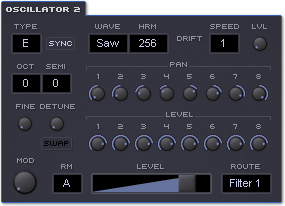
Blarg's oscillators can be assigned one of six unique modes of sound generation but each of these oscillator types share a set of common parameters which will be explained here.
| TYPE | Selects the sound generation mode from the range A to F. Depending on the type selected, the controls of the oscillator will change accordingly. The six oscillator types and the parematers unique to each of them are described in detail below. |
| SYNC | Restarts the oscillator's waveforms from the beginning of a cycle when a voice is triggered. |
| OCT | Tunes the oscillator's signal by up to three octaves up or down. |
| SEMI | Shifts the pitch of the signal by up to 11 semi-tones relative to the note being played. |
| FINE | Fine tunes the pitch by up to a sem-tone. To lower the pitch slightly, set the OCT control to -1, the SEMI control to 11 and adjust the FINE control to almost maximum. |
| DETUNE | A stereo detuner - this control raises the pitch of left channel channel whilst lowering the pitch of the right channel. |
| SWAP | Reverses the operation of the DETUNE control, so the left channel's pitch is lowered and the right channel is raised. |
| MOD | Modifies the signal in various ways. The effect this control has is dependent on the oscillator's mode selected by the TYPE control. Refer to the description of each oscillator type for further information about this parameter. |
| LEVEL | The volume of the oscillator's output. Note that this parameter can be controlled by any of the available modulation sources, so even if it is set to minimum, the oscillator may still produce a sound. |
| ROUTE | Sends the signal from the oscillator to any of the available modifiers or direct to the instrument's built-in effects, bypassing the filters etc.. Oscillators 1 and 2 have an additional Osc RM option in the ROUTE dropdown list. When this is selected, the oscillator's signal will modulate the amplitude of the selected oscillator's output. |
| RM | Selects the ring modulation mode. The different modes are identical to the ring modulator function of the Modulation Oscillator. This parameter is only available for oscillators 2 and 3. |
Type A - Dual Oscillator
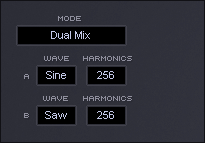
A signal is produced by combining two waveforms together in a variety of possible ways.
| MODE | Selects the manner in which wave A and B are combined. |
| WAVE | A choice of 11 different waveforms: SINE, SAW, RAMP 1, RAMP 2, RAMP 3, SQUARE, TRIANGE, PEAK, OCTAVA, CLUSTER 1, CLUSTER 2. |
| HARMONICS | The different waveforms are produced using additive synthesis by combining up to 256 sine waves. The number of harmonics above the fundamental frequency can be reduced here. If the selected waveform is a sine, this parameter will have no effect. |
Availble waveforms:

9 different modes are availble and in each case the oscillator's MOD control performs a different function:
| Single | Output is just Wave A, Wave B is ignored. MOD adjust the phase of the wave. So, provided the oscillator's SYNC button is lit, if the MOD control is set to half-way, the wave will start at half-way through it's cycle when a note is triggered. |
| Dual A+B | Wave A and Wave B are added together. MOD adjusts the phase of the waves. |
| Dual A-B | Wave B is subtracted from Wave A. MOD adjusts the phase of the waves. If identical waveforms are selected then the output will be silence. |
| Dual Mix | Wave A and Wave B are mixed together. MOD acts as a cross-fader between the two waves. |
| Dual Width A+B | Wave A and Wave B are added together. MOD adjusts the pulse width of the two waves. |
| Dual Width A-B | Wave B is subtracted from Wave A. MOD adjusts the pulse width of the two waves. |
| Ring Width | Wave A and Wave B are multipied together. MOD adjusts the pulse width of the two waves. |
| Ring Width +A | Wave A and Wave B are multipied together and then Wave A is added to the output. MOD adjusts the pulse width of the two waves. |
| PhaseDistort | The phase of Wave A is modulated by the amplitude of Wave B. MOD controls the depth of modulation. |
Type B - Pulse Width Oscillator
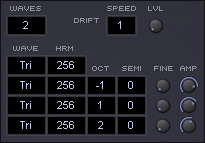
Up to four waveforms, each with indivual tuning and volume, are combined together.
| WAVES | Selects the number of waves to mix together. |
| DRIFT : SPEED | Adjusts the rate of simulated analog drift for the oscillator. Lower values produce a more chaotic variation in pitch. |
| DRIFT : LEVEL | Controls the maximum amount the pitch will vary from the base tuning of the oscillator. |
| WAVE | A choice of 9 different waveforms: PULSE 1, PULSE 2, PULSE 3, PULSE 4, TRIANGE, PEAK, OCTAVA, CLUSTER 1, CLUSTER 2. |
| HRM | Selects the number of harmonics which comprise the selected waveform. |
| OCT, SEMI, FINE | Tunes the pitch of waves 2,3 and 4 relative to oscillator's base tuning. |
| AMP | Adjusts the volume of each wave relative to the oscillator's base volume. |
The oscillator's MOD control adjusts the pulse-width of the waveforms. The effect of this on the different available waveforms is illustrated below:
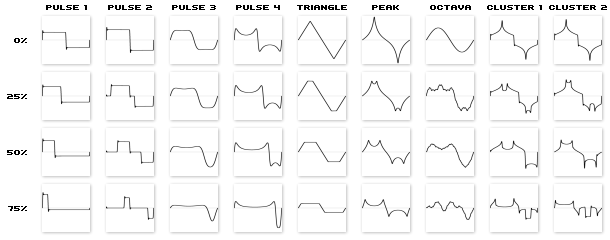
Type C - Modulation Oscillator
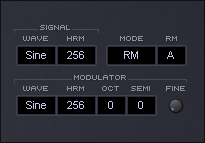
Modifies the shape of a waveform with a secondary waveform using ring modulation, phase modulation or both together. The oscillator's MOD control adjusts the depth of modulation.
| WAVE | A choice of 11 different waveforms: SINE, SAW, RAMP 1, RAMP 2, RAMP 3, SQUARE, TRIANGE, PEAK, OCTAVA, CLUSTER 1, CLUSTER 2. |
| HRM | Selects the number of harmonics which comprise the selected waveform. |
| OCT, SEMI, FINE | Tunes the pitch of the MODULATOR wave relative to the SIGNAL wave. |
| MODE | A choice of RM (ring modulation) where the volume of the signal is controlled by the volume of the modulator, PM (phase modulation) or RM+PM, a combination of the two. |
| RM | A choice of 20 ring modulation algorithms. |
The output produced by the ring modulation function given a sine wave SIGNAL and a sine wave MODULATOR 2 octaves higher:
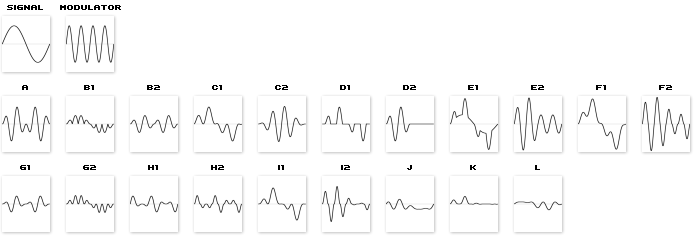
Type D - Noise Oscillator
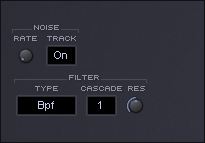
A noise generator with a pitch tracking filter. The noise is produced using a sample-and-hold algorithm, whereby a random signal is sampled at regular intervals and the output is fixed at that level for the duration of the interval.
The oscillator's MOD control adjust's the amount of smoothing applied to the output signal, reducing the digital artifacts produced when the signal changes instantly from one level to another.
| NOISE : RATE | Controls the sample and hold frequency. Lower values produce a more grainy, digital sound. Higher values more closely approximate white noise. |
| NOISE : TRACK | Enables or disables pitch tracking control of the sample and hold frequency. When this is set to On, the frequency specified by the RATE control is added to the oscillator's base frequency. |
| FILTER : TYPE | Four filter types are available: low-pass, band-pass, high-pass and notch. Also, the filter can be bypassed. |
| FILTER : CASCADE | Up to four filters can be chained in series. A higher number produces a steeper frequency roll-off. |
| FILTER : RES | The depth of resonance at the filter's cutoff frequency. |
Type E - Unison Oscillator
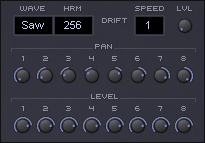
8 detuned waves are combined together. The oscillator's DETUNE control adjusts the range of frequencies the waves are spread across. The MOD control progressively increases the amount by which the waves are out of phase with one another.
| WAVE | Selects from 11 different waveforms: SINE, SAW, RAMP 1, RAMP 2, RAMP 3, SQUARE, TRIANGE, PEAK, OCTAVA, CLUSTER 1, CLUSTER 2. |
| HRM | Selects the number of harmonics of the waveform. |
| DRIFT : SPEED | Controls the rate of analog drift of the oscillator. |
| DRIFT : LEVEL | Adjusts the amount the pitch will drift away from the base tuning of the oscillator. |
| PAN 1-8 | Positions a component wave in the stereo image. |
| LEVEL 1-8 | Controls the volume of a component wave relative to the oscillator's overall volume. |
Type F - Spectrum Oscillator
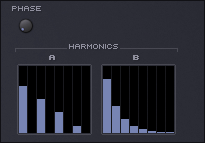
Up to eight sine waves are combined together, each a multiple of the oscillator's base frequency. The level of each sine wave can be specified independently. The oscillator's MOD control morphs the generated signal between two sets of levels.
| PHASE | Adjusts the phase of the oscillator's constituent waves. Generally this control won't have a noticeable effect unless the oscillator's SYNC button is lit and the sound is being heard in combination with the output of another oscillator. |
| HARMONICS | Click and drag the bars to adjust the volume of each of the eight harmonics. Hold shift while dragging for more precise adjustments. |